Chapter 1: Inside Sales: What and Why?
The sales environment has definitely changed during the last year. Since there’s been a rise in companies allowing their employees to work from home, the inside sales model (also sometimes referred to as virtual sales) became more prevalent.
But what is it exactly? How does it work? Let’s find out together!
What is Inside Sales?
The simplest answer to what is inside sales would be to say that inside sales is a dominant sales model that refers to selling products or services remotely, whether you’re working from the office or from the comfort of your home.
The inside sales model was popular enough even before 2020, but the SARS-CoV-2 pandemic definitely turned the tide in favor of inside sales, as many companies decided to let their employees work remotely.
Many field sales reps had to come back to the office or were sent to work from home. That factor alone makes inside sales a very popular model. In fact, according to the research done by Sales Benchmark Index, 75% of customers prefer to conduct business remotely instead of meeting face-to-face. And that was even before the pandemic. Interestingly, the inside sales model is growing in popularity fast. Well, 15 times faster than outside sales.
In order for the inside sales team to work perfectly, you need to have a good sales strategy that will highlight the sales skills and strengths of the teammates.
What’s more, outsourcing inside sales teams is also quite interesting. How does it work, you may ask? It’s nothing too complicated – the company outsources its inside sales responsibilities to a third-party team. Pretty simple, isn’t it?
Is Inside Sales the same as Telemarketing?
It’s pretty easy to confuse inside sales with telemarketing, but these are two entirely different branches, even though their origin remains the same. The only existing similarity is that inside sales reps use their phones to reach potential customers, just like telemarketers. But that’s it. Additionally, unlike telemarketers, inside sales reps don’t use scripts.
Even the premise of such a phone call is different. Telemarketers contact people to sell a product (B2C – business-to-consumer), whereas inside sales reps do so to conduct a business sale in a professional way (B2B – business-to-business), or in some cases B2C, but that’d concern only very profitable sales. Most companies that use the inside sales model use it mainly for SaaS or technology products or services.
What’s worth mentioning here is the fact that telemarketers are often hired to conduct prospecting. The main idea is for the telemarketers to find potential customers interested in the product or service. After accomplishing that, they set up a meeting between the customer and an inside sales rep.
Hiring an outside telemarketing agency to handle prospecting (also known as BPO – business process outsourcing) is generally a great idea but some B2B sales are too complicated to be done by using a script.
A little piece of trivia, inside sales even have their own association called AA-ISP The Global Inside Sales Association.
Two Types of Inside Sales: Home and Office
As we mentioned before, inside sales reps conduct business in either home or in the office. That doesn’t mean that they’re not proactive or productive workers, not in the slightest.
Being an inside sales representative means that you have to engage in a multitude of different work-related activities. From contacting new and prospective customers (unless your company uses telemarketers to do so) to keeping in touch with their already established leads.
Some companies may require inside sales teams to be present in the office and fulfill their responsibilities there, though during these uncertain times, a lot of companies decide to let their employees work from home.
If a person can arrange their time, duties, and responsibilities in the same way as they would in the office, then there are usually no objections to working from home.
Since inside sales reps don’t travel to meet clients, they use a variety of different means to contact their prospective customers like:
- Mobile devices;
- Video conferences;
- CRM software;
- Emails;
- Social media;
- And more.
Pros and Cons of Inside Sales
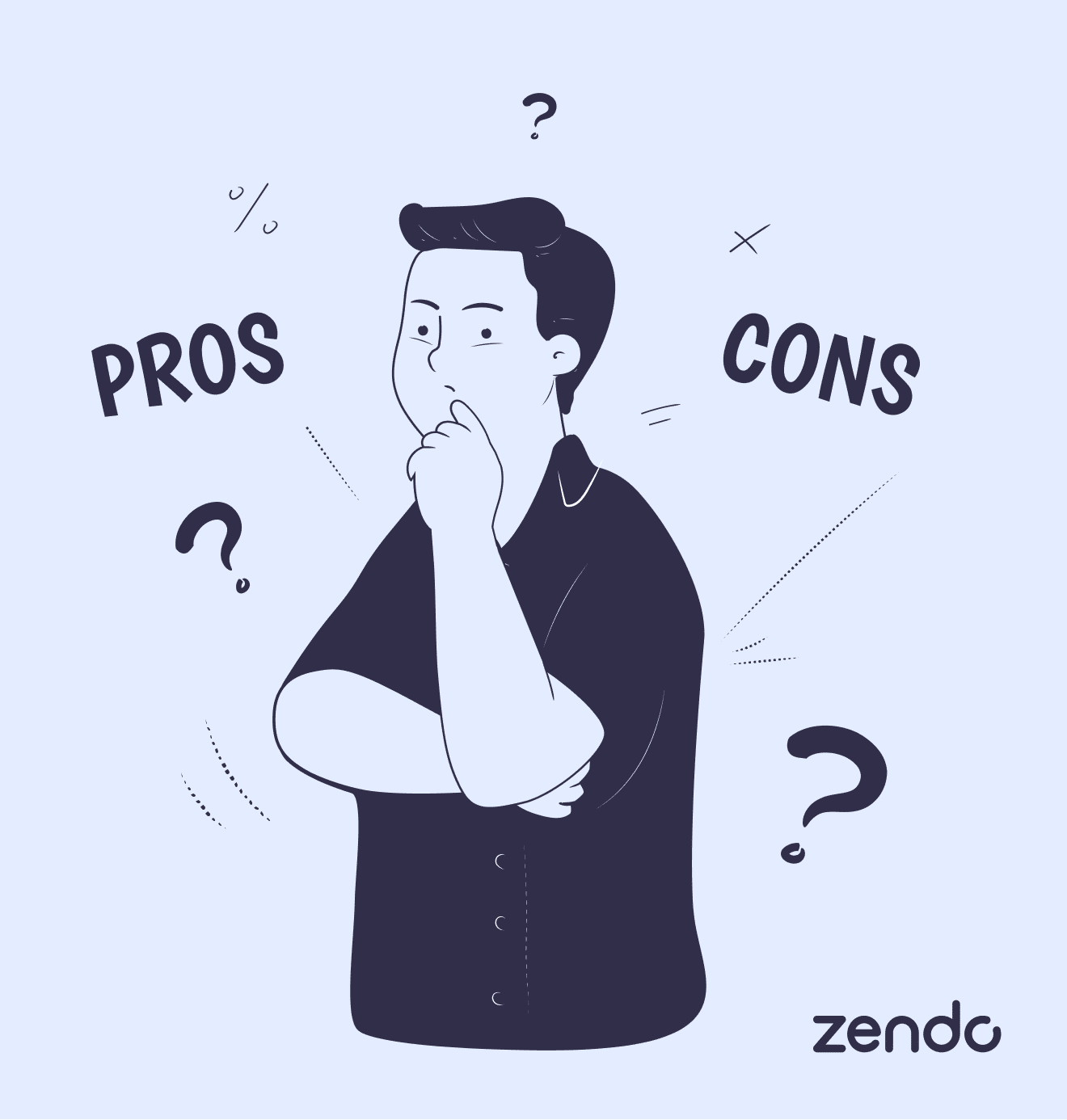
With inside sales being a popular model these days, it comes with many upsides. But as it’s with everything, it can’t be too perfect.
The Pros
One of the biggest advantages of the remote sales model is that sales reps have more selling possibilities, compared to outside sales, which we’ll cover in the next chapter. When it comes to reaching clients, the inside sales model offers a lot more opportunities. Thanks to the technology, inside sales reps can contact the leads via different devices, and that means almost unlimited possibilities. That advantage alone can make sales performance much better.
The model is also quite cost-effective. Having an on-site inside sales team instead of a field one can also cut costs quite a bit. Usually, an outside sales opportunity can cost around $308. On the other hand, there’s an inside sales call that costs a lot, and I mean a lot less – $50. Quite impressive, isn’t it?
Efficiency is another upside to inside sales. Since inside sales reps don’t travel and have face-to-face conversations, they can spend the amount of time traveling on other duties, like sending more emails or making more phone calls. Unfortunately, due to the fact that the inside sales reps don’t make face-to-face sales, it can result in smaller conversion rates.
Another two advantages of inside sales would be a faster completion of the sales cycle (often confused with the sales process, but it’s its part) and scalability. Depending on the needs and strategies, sales can be both scaled up or down.
The Cons
The first quite big disadvantage of selling remotely is the lack of opportunities to build meaningful sales relationships. Due to the fact that inside sales reps spend most of the time contacting the customers remotely, they can’t build a professional relationship, at least not on the same level as field sales. It’s definitely much harder to build trust without meeting the person face-to-face.
Selling high-ticket items may also be a pain in the neck. Again, it all comes down to remote work, or should I say, to the inside sales model. Most of the transactions that concern large amounts of money would probably require meeting the clients in person. Unfortunately, that’s not the case here.
Inability to demonstrate the product or read body language may make the potential clients less willing to make a purchase.
Routine may also impact some of the inside sales professionals. Even though clients differ, doing the same thing over and over again may lead to a routine that may impact the rep, make him or her less productive, and in some cases, make them not fulfill their duties.
Key Takeaways
Now you should be able to tell what’s inside sales, how it differs from telemarketing, and its pros and cons. Let’s quickly summarize what we’ve learned so far:
- Inside sales refers to selling a product or a service remotely;
- A correct sales strategy can go a long way and create more leads;
- Telemarketers usually sell business-to-consumer products, whereas inside sales reps sell business-to-business products and services;
- Inside sales reps typically work either from the office or from home.
In the next chapter, we’re gonna focus on the comparison between inside and outside sales, how they differ, what they have in common, and more.
Chapter 2: Inside vs Outside Sales: The Clash
Inside and outside sales, two branches of the same business, but is there a way to tell which one is better? There are plenty of opinions on that subject but one thing is clear. Outside sales, also known as field sales, has been with us for a long time. Inside sales, on the other hand, is a relatively new approach to selling that evolved from telemarketing.
Let the inside sales vs outside sales clash begin!
What is Inside Sales?
Inside sales means to sell something remotely, either from the comfort of your home or from the office. That also includes activities like prospecting, converting prospects to leads, closing deals, and more.
We’ve already described inside sales in detail in the previous chapter, therefore doing the same here would only unnecessarily prolong the article.
Now, it’s time to dive into outside sales.
What is Outside Sales?
Outside sales or as some people call it – field sales – is selling the product or service by traveling and meeting the clients face-to-face. Even though the SARS-CoV-2 pandemic has definitely left a mark on the field sales, it’s still a popular sales model.
But how and where do the outside sales professionals sell? Well, it can be a number of places. First of all, they can sell the products at various conferences, by visiting the client to meet him or her face-to-face, at industry events, or on trade shows.
Even though the outside sales model may be growing slower than inside sales, it definitely brings more revenue to the company. Due to the fact that outside sales reps meet their clients in person, they’re able to form a relationship and gain trust, on the contrary to inside sales representatives who sell over the phone. That factor allows the outside sales reps to sell products or services worth more money, resulting in scoring more profit.
Inside vs Outside Sales: How Do They Compare?

Now that we already know what inside and outside sales are, we can proceed further – to the clash itself.
Relationships
As we mentioned before, there’s a clear distinction between inside and outside sales when it comes to forming relationships and building trust with the clients.
In order for inside sales reps to reach their prospects, they have to make a phone call, send an email, schedule a Zoom meeting or contact the client via similar means.
Unfortunately, that isn’t enough for the sales rep to form a strong relationship. We all know that face-to-face interactions can impact our views of other people.
There’s a lot of things that influence such a process, for example, body language. When we’re meeting another person face-to-face, we can see how they react to certain situations, words, or sentences. We can match our body language and influence the other person by it. Unfortunately, that can’t be done while contacting the client remotely.
A different situation happens with outside sales professionals, as they’re able to observe and react to clients’ demands, body language, or facial expressions. That may seem like a small detail but in fact, it’s a key factor when it comes to building trust and relationships.
Close Ratio
When it comes to close rate statistics, outside sales lead the way. Due to the fact that outside sales reps meet with their prospects face-to-face, they have a 30.2% higher close rate compared to the inside sales teams.
That isn’t the only factor though. The difference between inside and outside sales strategies also plays a crucial role in the closing ratio. In the previous chapter, we mentioned the cost of an average inside sales call and outside sales opportunity. The inside sales call costs approximately $50 compared to the outside sales opportunity that can cost even around $300.
As you can see, the difference in the closing ratio also derives from the call cost, as it isn’t as big of a deal to lose $50 compared to $300.
In fact, the inside sales model has a lower CAC – Customer Acquisition Cost which makes it less risky.
Difference In Approach
Inside sales vs outside sales is an interesting clash as they both are sales models but focus on entirely different aspects.
The inside sales model focuses on quantity. The remote work enables the sales teams to reach a higher number of potential clients, resulting in more sales.
They use the Transactional Sales Model. By following this approach, sales reps don’t have to form relationships with their customers to sell a product or a service. Of course, some understanding and trust is required and welcome because otherwise, you wouldn’t be able to sell almost anything.
There aren’t many decision-makers, usually between 1-3. Similarly to what we mentioned in the previous chapter, the inside sales cycle is a much faster process (less than three months) compared to outside sales (more than three months).
On the other hand, we have field sales teams that use a different approach. They focus on the Relational Sales Model, hence meeting the clients in person. The number of decision-makers grows along the length of the typical sales cycle, with the former being four and more people, and the latter explained in the paragraph above.
Even though field sales reps may get in touch with a smaller amount of potential clients, they would probably land much more lucrative deals.
Technology
What do you think, which sales reps use more technological solutions in their daily work, inside or outside sales? Chances are, you guessed it right – inside sales reps!
But why does it happen? Well, it can be attributed to the fact that outside reps aren’t required to make as many important phone calls, whereas inside reps do so all the time. They use all kinds of software that can make their job easier and faster.
Some of the software would most likely include programs like RingCentral, CRM, VOIP, or other similar communication managers or software.
On the other hand, there are outside sales representatives that travel to meet their clients. The distinction here is very clear and the question of who uses more technological solutions can be answered without hesitation.
Sales Salary
And finally, the point of interest of many readers. Let’s not keep you waiting, shall we?
The inside sales vs outside sales clash continues, even when it comes to salaries. The former earns a bit less than the latter, i.e. around $10 thousand less. The average inside sales reps salary positions around $40,000 a year, whereas the outside sales reps can earn on average $50 thousand a year.
That, of course, excludes commissions and bonuses, but these are not as high for inside sales teams as they are for outside reps.
Key Takeaways
Inside sales vs outside sales battle comes to a close. Is there a winner? Not really. Both are extremely popular models, but these days inside sales is definitely having its moment.
To solidify all the important information in this chapter, take a look at the graphic below:
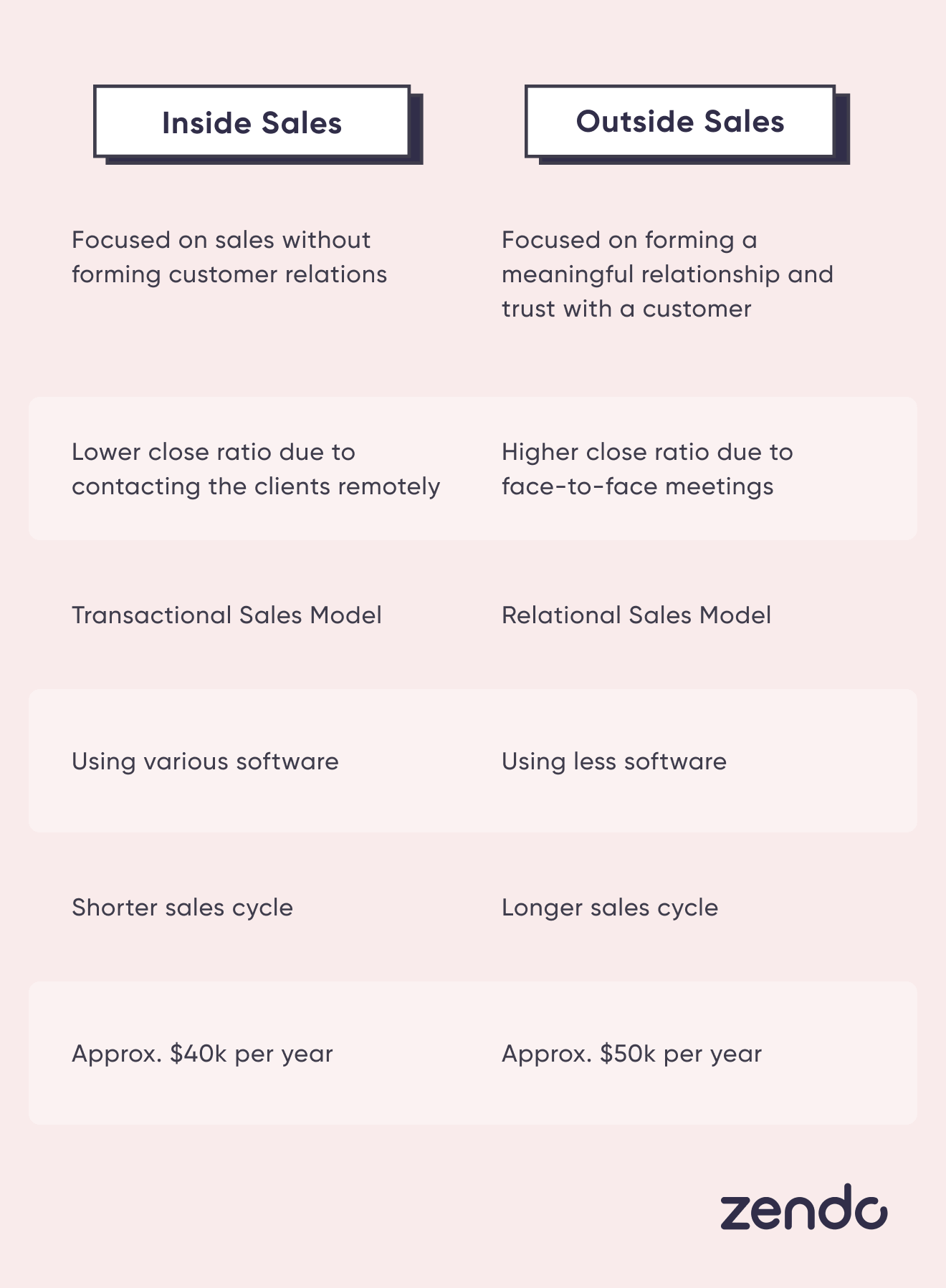
Chapter 3: Inside Sales: The Dream Team
Alright! We’ve gone through the basics, now let’s dive into some more detailed information. So far, we’ve covered subjects of what is inside and outside sales, how they compare, and what they do. This time, we’ll shift our focus to a different thing – the inside sales team structure.
Every sales team should be able to perform well, but how to make it happen? What sales roles should people have in a team? Let’s think about it right now.
Inside Sales Team Structure
Building a strong team is surely no easy task. Every person has to fill a role that concerns different responsibilities. Depending on the sales model, their roles may differ. Here, we’re focusing on inside sales.
The typical inside sales team should consist of:

Now, that we’ve listed the most important roles of the inside sales, let’s dive into them in detail.
Sales Development Representative
The role of the sales development rep is to find prospects, i.e. people showing the potential of becoming clients. Their core responsibilities are finding new customers, setting up appointments, and qualifying leads.
Of course, there’s more to this role. Sending cold emails or doing cold calls are also part of the sales development representative’s responsibilities. What’s more, they also take care of prospects that were already contacted. The aim is to reactivate the contact or picking the better moment if the prospect’s need hasn’t been met before.
Do you perhaps wonder what traits should a person in that role possess? Well, the ideal candidate should definitely be creative, patient, and needs to have a fitting manner of speech.
Interestingly, there are some that claim that the role of a sales development rep is slowly becoming unnecessary, though let’s not bother with it just yet.
Telemarketers
We mentioned it in the first chapter, but it’s worth stressing again. Telemarketers are sometimes used for inside sales as well. Even though they’re technically not part of the entire team, they still contribute to their overall success.
Inside sales companies sometimes decide on hiring an outside telemarketing agency. The reason why companies are doing that is because they need additional workers to handle prospecting. Such action is called BPO – business process outsourcing.
Sales Engineer
Inside sales engineer acts as a middleman between the inside sales company and its clients. The main objective and responsibility of a person in the sales engineer role is to provide any necessary help and advice for the clients. There’s more to the role though, as they also take care of creating reports, negotiating terms, pushing forward sales strategies, and more.
If you’d like to become a sales engineer, you’d have to be a great and passionate speaker with highly developed customer service skills. If you do, then your actions as a sales engineer could influence the client’s decision and by doing so, bring more profit for the company.
Account Executive
An account executive plays a very important and crucial role in the inside sales team. From taking care of generating leads, through building meaningful relationships with clients, to closing deals. Quite a lot isn’t it?
The main means of communication for account executives are the internet and phone. Additionally, with the growing popularity of video conferences, AEs would also take advantage of that technology.
Oftentimes when the sales development rep generates and qualifies the lead, it gets passed on to the account executive.
You may wonder, are there any particular skills that a person applying for such a position should have? Well, yes. In order to be a great account executive, a person should have extraordinary speaking skills, or to be more precise – communication skills, along with the ability to work with computer software on a high level.
Account Manager
The account manager is a very responsible role in the entire inside sales team. The person would be required to get the clients on board by presenting the service or product to them. Additionally, he or she would be responsible for activities related to the sales cycle, along with creating new opportunities.
If you’d like to be an account manager, you’d definitely need sales skills, self-motivation, an open mind, and many other essential skills. It would be your responsibility to know the service that you’d be selling in and out.
Since inside sales focuses on selling remotely, account managers are required to contact the clients via phone, email, video conferences, and other similar means.
Sales Operations
Every role we’ve mentioned in the article is really important and sales operations are no different. Even though technically it’s not a single role, but a team. Nevertheless, the responsibilities of sales operations involve measuring the effectiveness of current strategies and processes, developing training, strategies, and activities, all for the sole purpose of enhancing the sales, both in terms of profit and productivity.
Since we went through the general responsibilities of sales operations, we can now focus on different members of the team. The responsibilities of the sales operations team can be fulfilled by people in different roles, such as:
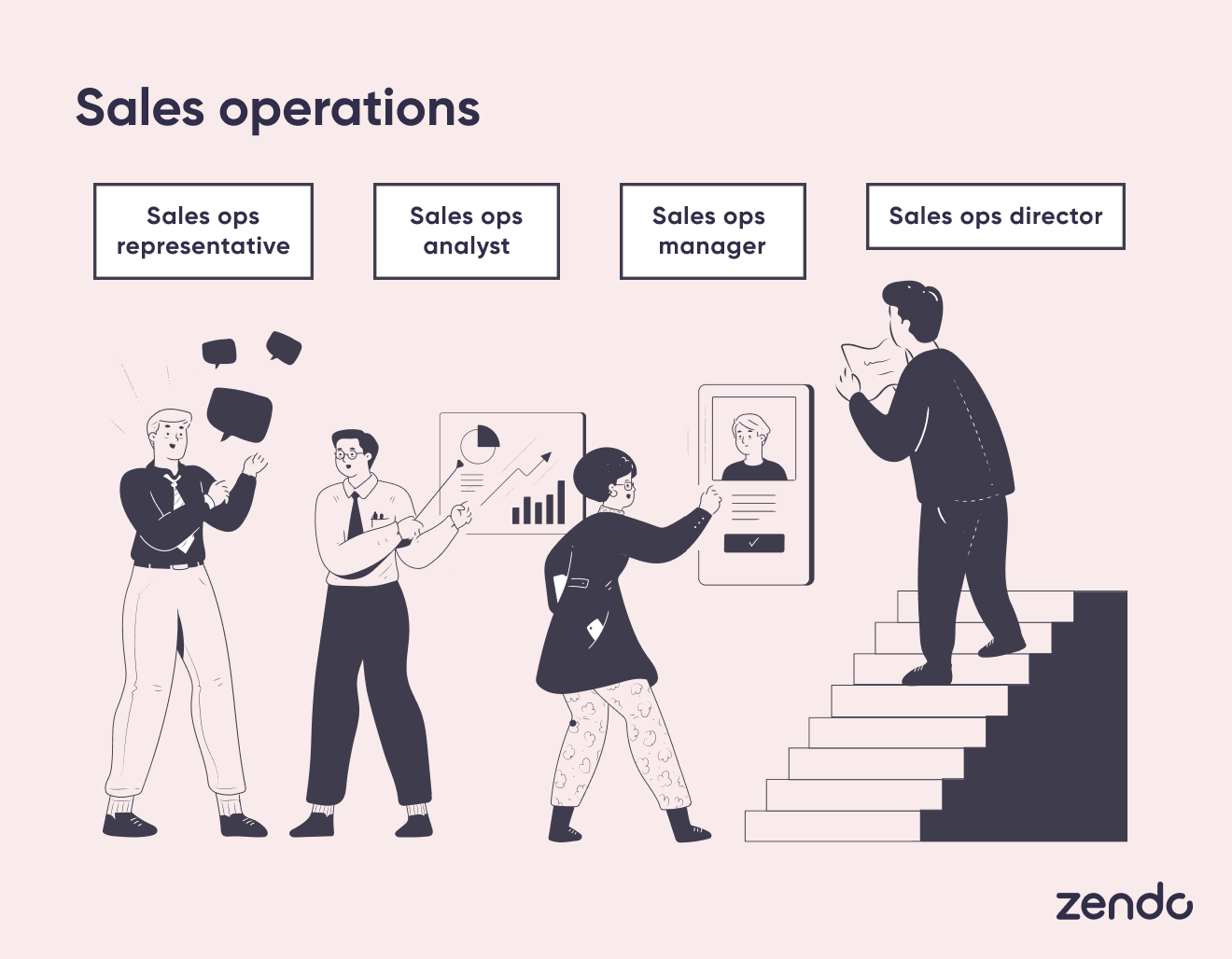
Sales Ops Representative
An entry-level position that requires a candidate to be a strong speaker with extraordinary communication skills. Not only that, a perfect candidate should also have at least one year of previous experience, along with high attention to detail and great marketing skills.
Sales Ops Analyst
The Sales Ops Analyst position requires more experience and knowledge compared to the previous one. The responsibilities include working with large amounts of data, reporting, analysis, marketing, and last but not least, thorough product knowledge, or in this case, the service.
Sales Ops Manager
As the name itself suggests, the position requires strong management skills and experience. What’s more, a candidate should also be able to show leadership and sales skills.
When it comes to experience, usually at least five years of previous sales employment is required.
Sales Ops Director
Sales Ops Director supervises the entire team, including the sales ops manager. Usually, with at least 10 years of previous sales experience, the director’s responsibilities include close cooperation with sales leaders, creating and optimizing sales processes, analyzing figures, and many more.
Key Takeaways
We went through the most important roles of the inside sales team, each of them different, yet all equally important. For your convenience, let’s remind each of them again:
- Sales development reps;
- Sales engineers;
- Accounts executives;
- Account managers;
- Sales operations.
Sales operations can further divide into:
- Sales ops representative;
- Sales ops analyst;
- Sales ops manager;
- Sales ops director.
In addition to the roles we mentioned above, telemarketers may be added, even though they’re not a part of your regular inside sales team.
Chapter 4: Inside Sales: How to Inside Sell Like a Pro?
Inside selling ain’t easy! So far we’ve covered the general idea behind inside sales, the comparison between inside sales and outside sales, and the dream team.
In the fourth chapter of our definitive Inside Sales Guide, we’ll focus on selling techniques. After all, our goal is to inside sell like a pro!
Inside Sales Selling Techniques
We’re pretty sure that a lot of aspiring salespeople ask themselves the question: how to sell? Well, there’s no recipe for it, but there are some techniques that may just provide you with the right skills to make the sales process easier.
There are a lot of different selling techniques out there, but fear not, we’ll explain them in a moment. Inside selling features a different set of techniques compared to outside selling. Even though some may remain the same, a vast majority of them will differ.
In this chapter of the Inside Sales Guide, we’ll focus on the following sales techniques:
- Cross-selling;
- Upselling;
- Cold calling;
- Cold mailing.
Cross-Selling

Cross-selling (often confused with upselling, which we’re going to cover next) is one of the most popular sales techniques to influence customers’ decision to buy related items to the one being purchased or already purchased. In the case of our guide, it’ll obviously refer to services, not products.
This technique is used by many large companies, for example, Amazon suggests a “buy with” option. However, that would apply to products and we focus on services, though we believe you see the picture. The question is, how do we apply cross-selling if we want to sell a service?
Well, it’s not that hard if you think about it. Let’s say, you’re selling a graphic design service. You can additionally offer a second service for half-price, or additional resources used for the design for a cheaper price.
Advantages of Cross-Selling
- Allows building high customer satisfaction and trust;
- Customers can choose from a wider range of products or services;
- If executed correctly, it can bring more profit to the company.
Disadvantages of Cross-Selling
- Customers might feel overwhelmed and lose interest;
- Requires personalization;
- Can result in unnecessary loss of profit when not executed properly;
- Focused on returning customers.
Upselling
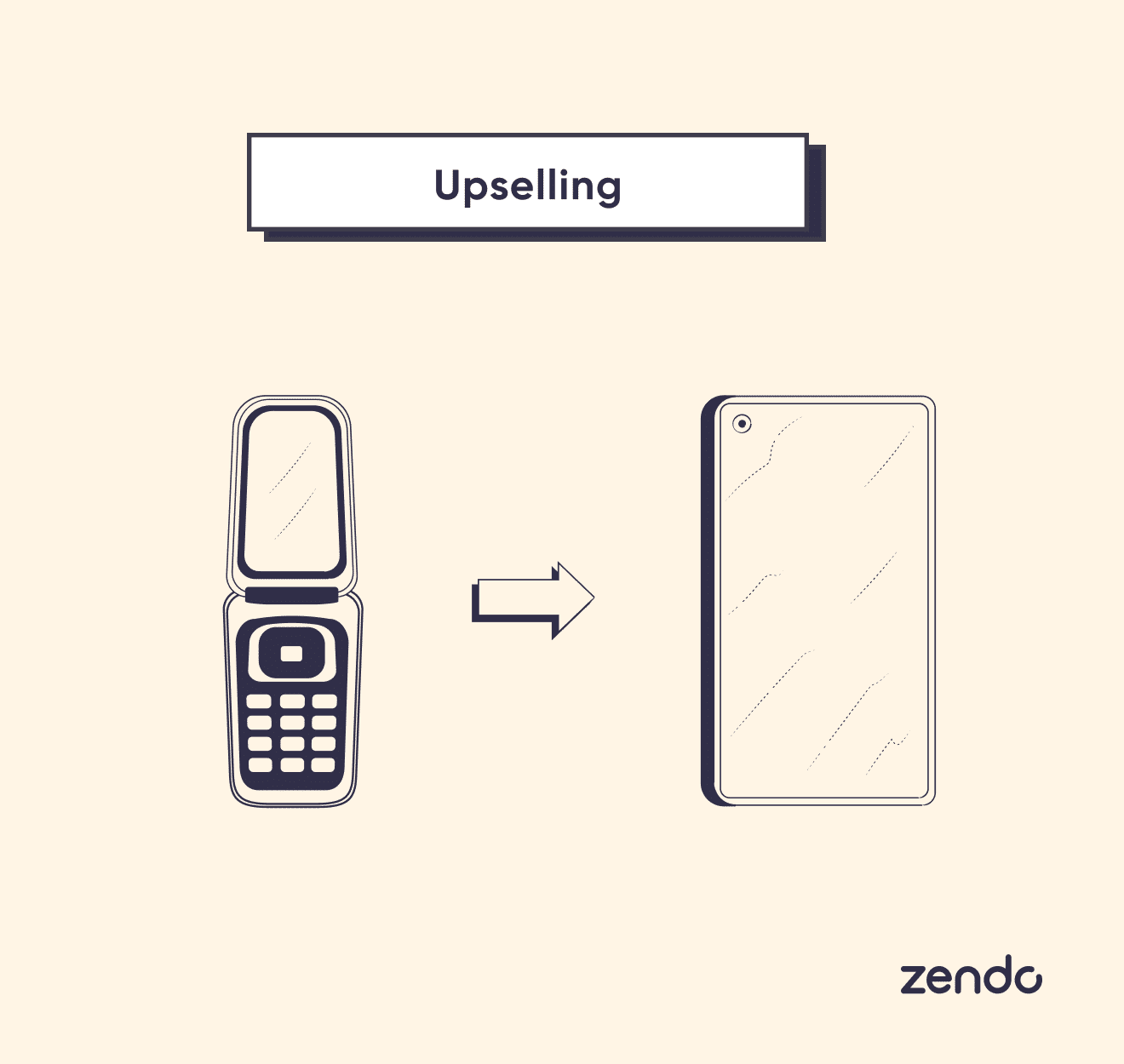
On the contrary to cross-selling, upselling is about pitching and selling an item or service of higher value, rather than cheaper.
Here, let’s use the example of a website that features various models of subscription. There are different options, with the first being free with limited functionalities, and the second being paid with much more available features and no limits, but of course, it has its price.
In upselling, trust and connection between the buyer and the seller should be developed. By doing so, customers can become long-time clients of the company.
If you want to succeed in upselling, you need to know the customers’ needs. Analyze your customer patterns and think about their needs. By doing so, you can come up with products that will suit them best.
If you’d like to check out how it works, visit either Fiverr or Upwork, these two are perfect examples that use upselling.
And that’s basically it when it comes to upselling.
Advantages of Upselling
- Higher CLV (Customer Lifetime Value);
- Ideal for building relationships with a customer;
- Higher customer satisfaction;
- When executed properly, it can benefit both sides.
Disadvantages of Upselling
- When executed poorly, customers will definitely lose interest;
- Might be badly perceived by salespeople;
- Focused on returning customers.
Cold Calling

A classic, yet very disliked form of communication between a salesperson and a potential buyer. Probably every single person in the world with access to a phone has been cold-called sometime in their life.
But what exactly is cold calling? It’s a selling strategy based on calling potential new customers without them knowing about the call prior. Even though cold calling is responsible for around a 2% success rate, it’s still one of the most popular selling methods.
In fact, nowadays cold calling is restricted by the Congress and has to follow certain regulations.
Advantages of Cold Calling
- Doesn’t require many resources;
- Ideal for starting sales reps;
- Plenty of potential customers;
- Quick solution.
Disadvantages of Cold Calling
- Fresh sales reps may quickly lose motivation;
- Customers usually don’t like it;
- May influence the company’s reputation if done badly.
Cold Mailing

Similar to cold calling, cold mailing is a sales technique based on sending an email to a customer who didn’t show previous interest in the product or service. Even though some people may consider the email as being spam, it definitely doesn’t serve that purpose.
The main goal of cold mailing is to make the potential customer interested in the product or service. How to make it happen? Well, you can start with addressing the client directly by personalizing the email. Moreover, avoid using false information, but rather focus on conveying a true and honest message.
Cold mailing can bring a company a lot of profit. Sending cold emails can contribute to a higher number of leads, new employees, statistics, and more! Speaking of statistics, the average open rate of cold emails in 2019 was 22.15%. How about the response rate? Well, it doesn’t look that great. Only 1 person per 100 answered the email.
Advantages of Cold Mailing
- Quick and efficient;
- Can be personalized;
- Informative;
- It’s much easier to find someone’s email address than a phone number;
- Less disliked by the customers than cold calls.
Disadvantages of Cold Mailing
- No immediate response;
- May not reach prospect due to cluttered inboxes;
- Subject to CAN-SPAM Act if done badly.
Key Takeaways
We went through the most common and most popular techniques used by inside salespeople. In order to succeed in the industry, you should remember that:
- Cross-selling is a technique used for persuading the client to buy related products;
- Upselling is used for suggesting a better or enhanced version of a product or service;
- Cold calling is the fastest technique when it comes to reaching the client but may be perceived as unwelcome;
- Cold mailing can be personalized but may end up in a spam folder.
Chapter 5: Inside Sales: How to Find Prospects
At first glance, prospecting may seem like an easy task, but in reality, it’s more difficult than you might think. In fact, it may result in hours spent on finding the proper prospects.
In this chapter, we will focus on answering the question of how to successfully find and contact prospects.
What is Prospecting?
Prospecting, simply speaking, means searching. It’s an initial step in the process of finding a potential customer.
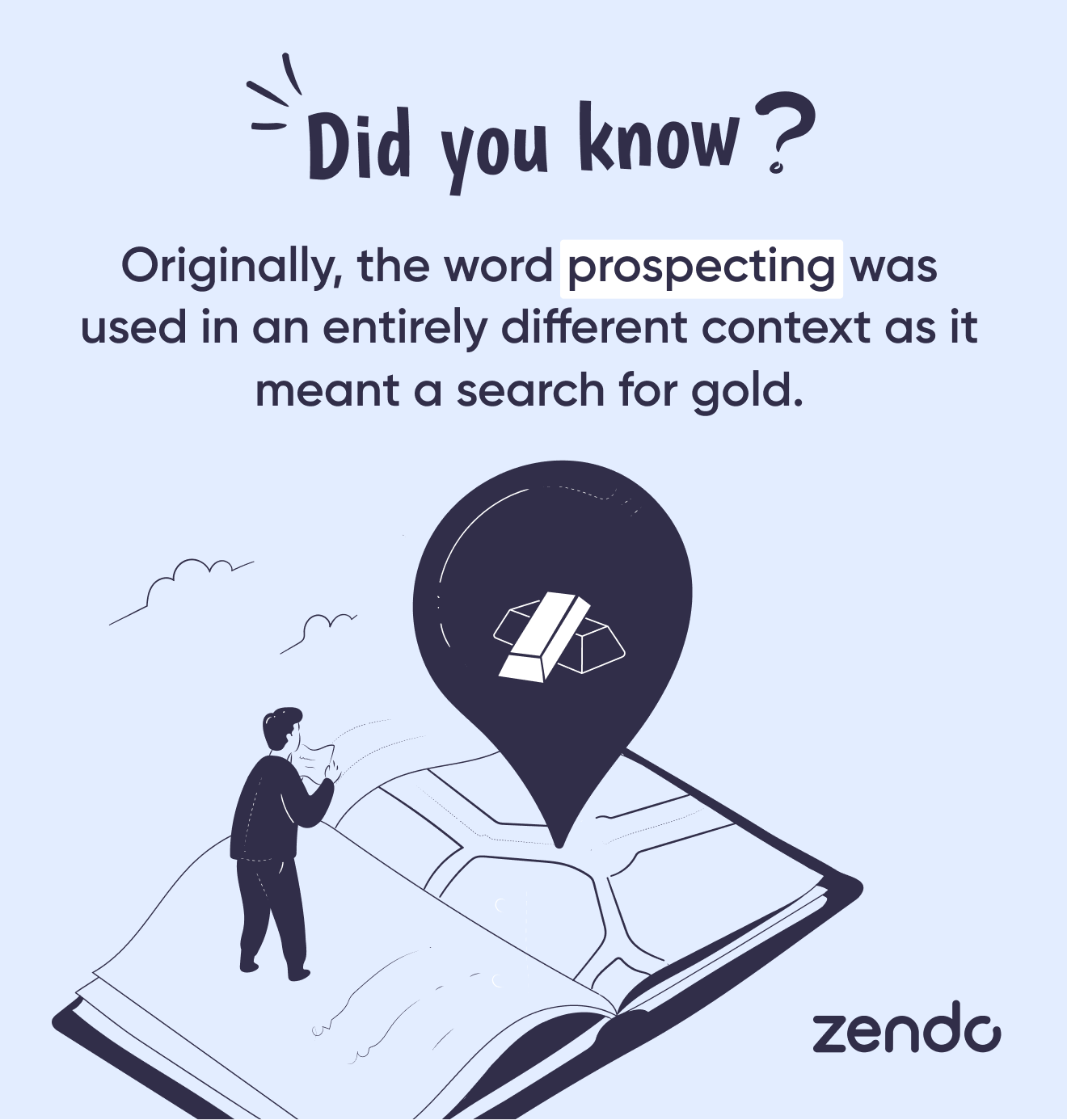
Prospecting includes thorough research of the client’s needs before making any contact. By doing so, the inside sales representative can know the potential customer more, and by sending him or her a personalized email or making a phone call, the rep can significantly raise the chances of converting the prospect into a lead, and perhaps with a bit of luck – into a buyer.
It all seems easy and pleasant, though bear in mind that prospecting is actually one of the harder steps. In fact, over 40% of sales representatives (not just inside sales) admitted that prospecting is the most difficult part of the entire sales process.
You may wonder, why should you start prospecting? The answer is really simple! Thanks to this step, the rep can enhance sales; after all – more prospects equals more sales.
Who are Prospects?
In simple terms, prospects are people that you make contact with. They don’t know you (yet), didn’t hear from you before, and certainly – they don’t expect you to make contact with them. If it’s successful, prospects can turn into leads. But what about sales techniques? Which ones should you use? Well, in the previous chapters we mentioned various ways of reaching the customers, among them – cold calling and cold mailing, and these would definitely do well.
How to Find Prospects?

Finding prospects and convincing them to buy the service may require a lot of patience and effort. Some customers may be unaware that the service they’re looking for has just been released. Your job is to make them aware that you’re offering such a service and to pitch the idea to them.
That being said, we’ve prepared a few steps to help you get to know the process more and hopefully help you get more sales!
Think about your ideal client.
Before proceeding to make contact with your potential prospects, think about what you want to sell, why should they buy the product or service, or how will it make their life easier? Analyze your current and previous clients, perhaps some of them would love to use the service that you’re offering at the moment.
We know, it’s an obvious step, but it deserves to be stressed! Preparing information about your potential prospects, researching them, thinking about their needs, or simply knowing their name and basic information can go a long way in building trust and business relationships.
How should you approach them?
This one might be a little bit tricky. Should you send an email? Or perhaps a phone call would turn out better? Well, you can try both, however, you should also take into consideration the numbers.
According to statistics found on HubSpot, 8 out of 10 prospects prefer email communication. On the other hand, 42.2% of sales reps claimed that they find phone calls as the best way of communication.
Personalize.
Each phone call you make or each email you send should be personalized. By doing so, you can not only make the customer feel more comfortable but also increase the chances of successfully closing the deal. You should remember that decision-makers are flooded with thousands of general sales pitches. You don’t want to fall into the category of yet another sales email that either won’t be opened or will land in spam.
Make sure you ask the right questions, especially open-ended ones. Moreover, do your best to make the prospect feel like you’re not trying to sell a service at all costs, but rather that you’re there to help the customer make the right decision.
Make contact.
Having done all the steps above, the last and final step is to make contact with the prospect via the means of your choice. If you don’t know which communication means to choose, use one of the techniques that we mentioned in the guide. That should help you out!
If you followed the steps, personalized messages, thought out the best way to approach the client, and asked the right questions, you should now have a buyer instead of a prospect!
Key Takeaways
Now you should be able to successfully prepare for prospecting. To further solidify the knowledge gathered in the chapter, take a look at these few steps that we’ve prepared for you.
- Before making any contact, think about the needs of your former or present clients. How will your service help them achieve their goals? Are there going to be new clients? How should you convince them to buy the service?
- Think about different means of communication. If you’re going to be contacting new clients over the phone, you might as well use cold calling. If it’s going to be an email, go ahead and pick cold mailing. It’s all up to you;
- And last but not least, personalize! This one is really important as personalization goes a really long way when it comes to establishing meaningful relationships with clients.
Chapter 6: How to Successfully Close a Deal?
We dedicated the previous chapter in its entirety to the task of finding prospects. Of course, it’s one of the most important steps in the entire sales process, but what should you do once you find prospects that turned into leads? How should you proceed in order to be successful?
The last chapter of our Ultimate Inside Sales Guide will focus on the issue of closing a deal as well as on closing techniques.
That being said, let’s get to it.
How to Close a Deal?

Closing a sale is the ultimate culmination of every step you have taken in an entire sales process. It will certainly verify your skills as an inside salesperson as well as your interpersonal skills.
That being said, let’s raise a question: how to effectively close a deal?
Unfortunately, it’s not as easy as it sounds. In order to succeed in closing a deal, you have to be an excellent salesperson that carefully chooses the right phrases and words in a conversation. Not only that, but you should also use one of the sales closing techniques that we are about to dive into.
Closing Techniques
Let’s start by asking a question: what is a sales technique? In simple terms, it’s a set of rules, guidelines, and suggestions that sales reps should follow to successfully sell the product or service.
The variety of different sales closing techniques is not making it any easier for the sales rep. At first, it might seem like a real challenge to pick a proper one, but we’re here to help you make the right choice!
The Now or Never Close
The main goal of this sales closing technique is to incite the customer to buy the service or product immediately. It includes giving the customer a special benefit, bonus, free gift, or discount if they make the purchase right now, or during the span of the day.
Example sentence: “If you’ll be ready to make a decision by the end of this day, we’ll be able to give you X for free as a bonus.”
The Take Away Close
Have you ever been in a situation where you were so close to finalizing a sale, but your customer was hesitant to proceed? If you were, then this technique may prove to be a life-saver.
Using this sales closing technique not only shows your confidence in the product or service you’re offering but also makes you more believable in the eyes of your customer.
In fact, all you need to do is withdraw a piece of your offer from the customer at the moment of their hesitation. By doing this, your customers may feel like they’re losing their chance.
Let’s say that your client needs a team of developers for his project, you’ve already introduced each other and the members of the team. You can proceed with something along those lines: “Our team is ready to begin in 30 days. However, I’m afraid that if we’re not going to be able to close the deal, our developers may be assigned to other tasks.”
A piece of advice – do it carefully, as some customers may feel like you’re abandoning them and they will not like to proceed.
The Assumptive Close
The assumptive technique can be found among the most popular ones used by sales reps. Its main idea is to assume that the deal you’re trying to close will result in success.
From the first email, through any other message exchange, you need to believe that the deal will be closed. When contacting a customer, always send a positive message, for example, ask when you should get started with onboarding, or what option of the service he or she chooses.
Take a look at this example: “Hey Mark, I’m thrilled to say that you’re going to be amazed by the product. Our client management system will definitely help you out. One more thing, would you like to proceed with the platinum or premium version of our service?”
Be careful, though, some customers may find it pushy, so choose your vocabulary wisely.
The Summary Close
One of the worst moments for a sales rep is the time when the customer hesitates. The summary close helps sales professionals avoid such situations by summarizing the product or service, enumerating its advantages, and pointing out the values that the solution will bring to the customer.
Usage example: “From what you say, I can see that our free trial period has influenced traffic on your website. Thanks to our service, you were able to increase traffic and sales, communicate with your customers more effectively, as well as handle orders much faster. Since it did provide you with great value, I’m going to send over the papers to finalize the agreement.”
Using this method has one goal and it’s convincing the customer that the service you’re offering will greatly benefit their needs. This technique can be used not only in times of hesitation but also during long sales processes.
The Ben Franklin Close
We all know who Benjamin Franklin was, but did you know that he used to make a list of pros and cons in moments of hesitation? And this is what this sales technique is all about – pros and cons.
It’s an ideal closing technique whenever you see that your customer can’t make up his mind about whether to buy the service or not. Preparing a list of pros and cons and presenting the said list to the customer may convince him to finalize the deal.
So we have to ask ourselves a question – what would Benjamin Franklin do? Probably something along those lines: “Hello George, since you’re still not sure about our service, I have prepared a list of pros and cons for you to take a look at. We’re sure that the service we offer will greatly benefit your company. Find the attached list below, take a look, and let me know how you feel.”
Please remember though, your pros list should be at least twice as big as the cons list, otherwise, you might achieve a result that’s not quite what you expected.
The Question Close
“What else would you need from our end to be ready to make the purchase decision?”
The question above is a simple example of how to use the question close. There’s really not that much to it, you simply need to ask your customers questions.
Asking the right questions gives you a better understanding of your customer’s potential issues with the service. What’s more, knowing your customer’s objections allows you to explain and clarify any misunderstandings.
Questions can be asked at any moment during the process – in the beginning, during, or in the end, to finalize the sale.
The Puppy Dog Close
Don’t let the name fool you, we’re not dealing with animals here. The resemblance of the name, however, to actual actions is not coincidental.
We all love to try something out before committing fully. The same thing applies to sales, where a salesperson lets the customer try a piece of the service or product beforehand. By doing so, you can ensure that the service you’re offering is ideal for the customer.
For example: “I’m wondering if you’d like to try out our service for one week, free of charge? Then, you’d be able to decide whether you liked it or not.”
There’s a catch, though. You need to make sure of two things. Firstly, you need to be certain that the service you’re offering is of the best quality. You can’t risk letting your customers try out the unfinished or bugged service. Secondly, make sure that your supervisor agrees with the technique in order to avoid any unnecessary tensions.
The Sharp Angle Close
Last but not least, is the sharp angle closing technique. Imagine that you’re in a situation where sealing the deal seems certain, but suddenly your customer asks you a question about a free bonus. What do you do in such a situation?
If you have a free hand in dealing with such moments, you can negotiate. For example, let’s say that a customer asks for an additional module (that normally requires a payment) on your SaaS website. What should you do? Shift your attention to a different customer? Not at all! You can reply by saying that you sure can do that, but they need to close the deal today or refer you to their colleagues that might also need such a solution.
Whether or not the customer agrees with your proposal is up to you and how you can handle it.
Key Takeaways
We’ve gone through eight different sales closing techniques that we think are the most effective ones. You should remember that:
- The now or never close can be used to encourage customers to buy the service immediately;
- The take away close is meant to be used in situations where customers are hesitant;
- The assumptive close makes customers feel that you’re confident in what you’re offering;
- The summary close serves the purpose of summarizing all the benefits of your service;
- The Ben Franklin close allows you to present the list of pros and cons to your customers;
- By using the question close, you can find out what potential issues your customers may have with the service;
- Letting customers try out a piece of service or product is what the puppy dog close is about;
- The sharp angle close allows you to negotiate with a customer.
Conclusions
This is the end of our Ultimate Inside Sales Guide. If you read the whole guide, by now, you should know:
- What is inside sales, its two types, and its pros and cons;
- The difference between inside and outside sales;
- How your inside sales team should look like;
- Different selling techniques;
- How to find prospects;
- Different sales closing techniques.

We certainly hope that you found our guide useful. Now, grab your phone, laptop, or any other device and start inside selling like crazy!
Frequently Asked Questions: Inside Sales
What is inside sales?
Inside sales is, in other words, selling something remotely, either from home or from the office. The term inside sales, however, includes more than just that. All the activities connected to it like prospecting, converting, closing deals, and others, are also included.
What is outside sales?
On the contrary to inside sales, outside sales is selling on-site. It essentially means to go out and sell products or services face-to-face.
What roles are there in the inside sales team?
Usually, the inside sales team consists of sales development representatives (like telemarketers), a sales engineer, an account executive/-s, an account manager, and sales operations.
What are selling techniques?
Selling techniques are different ways of convincing the client to convince the customer that your product is worth purchasing. Selling techniques include but are not limited to cross-selling, upselling, cold calling, or cold mailing.
Who are prospects?
Essentially, prospects are people who you make contact with that didn’t know or heard from you before.

A free online training. Delivered daily to your inbox to grow your productized agency.











